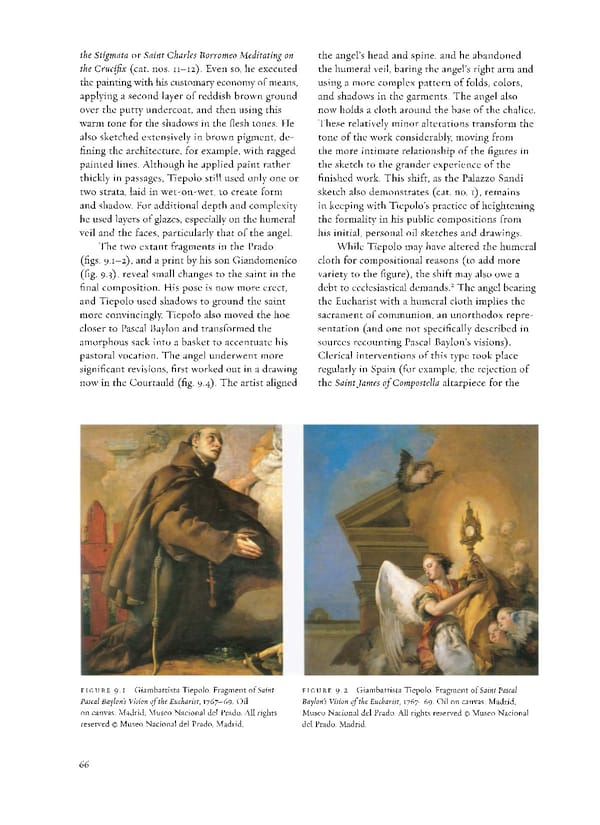the Stigmata or Saint Charles Borromeo Meditating on the angel's head and spine, and he abandoned the Crucifix (cat. nos. 11—12). Even so, he executed the humeral veil, baring the angel's right arm and the painting with his customary economy of means, using a more complex pattern of folds, colors, applying a second layer of reddish brown ground and shadows in the garments. The angel also over the putty undercoat, and then using this now holds a cloth around the base of the chalice. warm tone for the shadows in the flesh tones. He These relatively minor alterations transform the also sketched extensively in brown pigment, de- tone of the work considerably, moving from fining the architecture, for example, with ragged the more intimate relationship of the figures in painted lines. Although he applied paint rather the sketch to the grander experience of the thickly in passages, Tiepolo still used only one or finished work. This shift, as the Palazzo Sandi two strata, laid in wet-on-wet, to create form sketch also demonstrates (cat. no. i), remains and shadow. For additional depth and complexity in keeping with Tiepolo's practice of heightening he used layers of glazes, especially on the humeral the formality in his public compositions from veil and the faces, particularly that of the angel. his initial, personal oil sketches and drawings. The two extant fragments in the Prado While Tiepolo may have altered the humeral (figs. 9.1—2), and a print by his son Giandomenico cloth for compositional reasons (to add more (fig. 9.3), reveal small changes to the saint in the variety to the figure), the shift may also owe a final composition. His pose is now more erect, 2 debt to ecclesiastical demands. The angel bearing and Tiepolo used shadows to ground the saint the Eucharist with a humeral cloth implies the more convincingly. Tiepolo also moved the hoe sacrament of communion, an unorthodox repre- closer to Pascal Baylon and transformed the sentation (and one not specifically described in amorphous sack into a basket to accentuate his sources recounting Pascal Baylon's visions). pastoral vocation. The angel underwent more Clerical interventions of this type took place significant revisions, first worked out in a drawing regularly in Spain (for example, the rejection of now in the Courtauld (fig. 9.4). The artist aligned the Saint James ofCompostella altarpiece for the FIGURE 9.1 Giambattista Tiepolo. Fragment of Saint FIGURE 9.2 Giambattista Tiepolo. Fragment of Saint Pascal Pascal Baylon's Vision of the Eucharist, 1767-69. Oil Baylons Vision of the Eucharist, 1767-69. Oil on canvas. Madrid, on canvas. Madrid, Museo Nacional del Prado. All rights Museo Nacional del Prado. All rights reserved © Museo Nacional reserved © Museo Nacional del Prado, Madrid. del Prado, Madrid. 66
 Giambattista Tiepolo: Fifteen Oil Sketches Page 66 Page 68
Giambattista Tiepolo: Fifteen Oil Sketches Page 66 Page 68